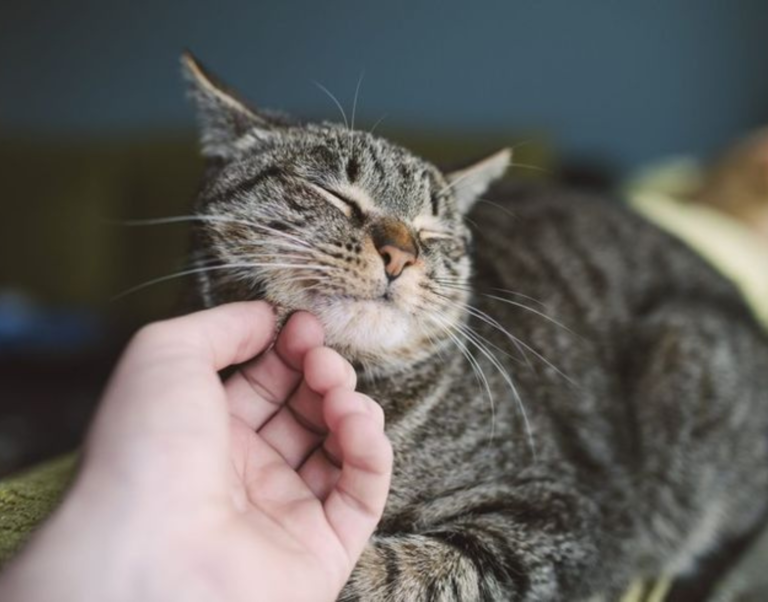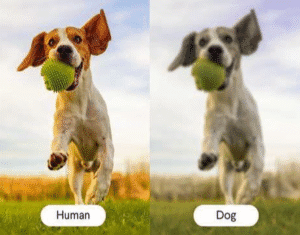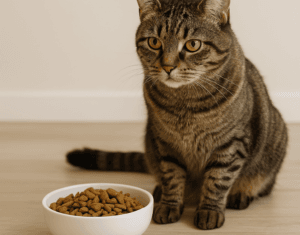Cats are fascinating creatures, and one of their most intriguing behaviors is purring. You may have observed your feline friend purring while being petted or simply relaxing on your lap. But why do cats purr?
In this section, we will delve into the reasons behind this unique behavior and explore the significance of cat purring. By gaining a deeper understanding of the secret language of cats, you can develop a stronger bond with your furry companion.
The Physiology of Cat Purring
Have you ever wondered how cats produce that soothing purring sound? The feline purring mechanism is a fascinating topic that has intrigued experts for years.
Physiologically speaking, cats produce the purring sound by vibrating their vocal cords at a frequency of 25 to 150 Hertz. This vibration occurs when the cat’s brain sends a signal to the laryngeal muscles, causing them to twitch and vibrate. The air that passes over the vibrating vocal cords creates the sound we know as purring.
| Physiological Aspects of Cat Purring | Beschrijving |
|---|---|
| The Larynx | The larynx is responsible for vibrating the vocal cords, creating the purring sound. |
| The Brain | The brain sends a signal to the laryngeal muscles to twitch and vibrate, producing the purring sound. |
| The Diaphragm | The diaphragm plays a role in regulating the airflow to the lungs, enabling cats to purr continuously for extended periods. |
Interestingly, cats can purr both when inhaling and exhaling, enabling them to purr continuously for extended periods. This is due to the unique structure of the feline diaphragm, which allows cats to regulate the airflow to their lungs while maintaining the purring vibration in their larynx.
The Physiology of Cat Purring
“The purring mechanism of cats is a fascinating physiological process that has puzzled scientists for decades.”
De feline purring mechanism is a complex process that involves the coordination of various bodily functions. Understanding this mechanism can help us appreciate the remarkable abilities of our feline friends and deepen our bond with them.
- Did you know that not all cats can purr? Domestic cats, cheetahs, and some wild cats can purr, while lions, tigers, and leopards cannot.
- The reason behind this difference lies in the structure of their larynx, which determines whether or not they can produce the purring sound.
Next time your cat snuggles up and starts to purr, you can marvel at the fascinating physiological process that enables this unique behavior.
Communication through Purring
Cats have a unique way of communicating, and purring is one of the most fascinating methods they use to communicate with their owners or fellow felines. While cats purr for various reasons, they also use this behavior as a form of communication. Understanding why cats purr and what they are trying to convey can help you develop a stronger bond with your feline friend.
When cats purr, they often use it as a means of expressing contentment or happiness. It’s common for cats to purr when they are relaxed, enjoying affection, or even while they are sleeping. In such cases, the purring is a sign of their comfort and satisfaction.
However, cats also purr in different scenarios that may signal different emotions, such as when they are in pain, anxious, or seeking attention. In such cases, the purring can indicate a need for help, reassurance, or simply a desire for company.
Did you know that when a cat purrs while being petted, it could be an indication that they are feeling loved and secure?
Additionally, cats may also purr to communicate with their owners or other felines. When cats are near each other, they use purring as a way of saying “hello” or “I’m here.” They also use purring as a means of comforting and reassuring each other, especially during stressful situations or when they are ill.
Knowing when and why your cat purrs can help you understand their needs and emotions more effectively. By listening to the variations in their purring behavior, you can differentiate between a happy purr and a distress purr, and respond accordingly.
Emotional Benefits of Cat Purring
Did you know that cat purring can provide emotional benefits for both the cat and their human companions? Purring is not just a sign of contentment; it can also indicate pain relief and healing.
Cats have a unique ability to heal themselves through purring. The frequency of the purring sound, which is between 25 and 150 Hz, has been shown to promote bone density and tissue regeneration, helping to heal injuries and reduce pain.
“The vibration of purring can help soothe your cat during times of stress and anxiety, and can also have a calming effect on you.”
Additionally, the act of purring can have a calming effect on both cats and humans. It has been shown to lower blood pressure and reduce stress levels, making it an effective tool for managing anxiety and depression.
When your cat purrs, it is a sure sign that they are feeling relaxed and content in your presence. By understanding the emotional benefits of cat purring, you can better appreciate the bond you share with your feline friend and appreciate the many ways they enhance your life.
The Significance of Cat Purring
Have you ever wondered why your cat purrs? The significance of cat purring is multifaceted and can provide insights into your feline friend’s behavior. Understanding cat purring can help you bond with your cat and create a deeper connection.
Cats purr in various contexts, and it’s important to understand what they might be trying to convey through their purrs. For example, cats often purr while they are being petted or stroked, which can indicate contentment and relaxation. Purring can also signify a need for attention or a desire for physical touch.
Fun Fact: Did you know that cats can purr while both inhaling and exhaling? This unique ability sets them apart from other animals, as most can only make vocalizations while exhaling.
Another significant aspect of cat purring is its ability to promote emotional well-being. Studies have shown that cats who purr may experience a release of endorphins, which can promote healing and provide pain relief. Purring can also provide comfort to cats in stressful situations, such as during visits to the vet or during thunderstorms.
To truly understand the significance of cat purring, it’s important to pay attention to your cat’s body language and take note of when they are purring. Observing your cat’s behavior can help you form a deeper connection and strengthen your bond.
Reasons Behind Cat Purring
Have you ever wondered why your furry companion purrs? Understanding the reasons behind cat purring can give you valuable insight into your cat’s behavior and emotional state. Here are some of the most common reasons why cats purr:
| Reden | Beschrijving |
|---|---|
| Expressing Happiness and Relaxation | Cats often purr when they’re happy and content. Purring can be a sign that your cat is feeling comfortable, safe, and relaxed. Your cat may purr when you pet them, when they’re cuddled up in their favorite spot, or when they’re napping. Purring can also be a self-soothing behavior for cats. |
| Seeking Attention | Cats are social creatures and enjoy spending time with their owners. Purring can be a way for your cat to get your attention and express their desire for affection or playtime. Your cat may purr loudly and rub against your legs, signaling that they want some love and attention. |
| Healing and Relieving Stress | Studies have shown that the vibrations created by purring can have healing and therapeutic effects on cats. Purring can help reduce stress, lower blood pressure, and promote healing of bones and tissues. Some cats may purr when they’re feeling unwell, as a way to help themselves feel better. |
| Communicating with Their Young | Mother cats often purr to communicate with their kittens. Purring can be a way for a mother cat to bond with her offspring, comfort them, and let them know that everything is okay. Kittens may also purr when they’re nursing, signaling to their mother that they’re content and happy. |
Keep in mind that every cat is unique, and there may be other reasons why your cat purrs. By paying attention to your cat’s behavior and body language, you can better understand what your cat is trying to communicate through their purrs.
Understanding Cat Purring Behavior
As a cat owner, it’s essential to understand your furry companion’s purring behavior. While it may seem like a simple and straightforward action, purring can hold different meanings, depending on the context and situation.
One of the primary reasons cats purr is to express contentment or pleasure. When your cat is relaxed, happy, or enjoying your company, you may notice them purring softly. However, cats can also purr when they are in pain or anxious, so it’s crucial to pay attention to your cat’s body language and other indications to determine their emotional state.
Cats may also purr to communicate with their owners or other cats. When seeking attention or food, cats may purr loudly to express their needs. Similarly, mother cats purr to communicate with their kittens, particularly during nursing or grooming.
Interestingly, recent studies suggest that purring has potential healing benefits for cats. The low-frequency vibrations of purring could promote healing and reduce inflammation, leading to accelerated recovery after an injury or illness.
Overall, cat purring behavior is complex and multifaceted. By paying attention to your cat’s purring habits and body language, you can gain a deeper understanding of their emotional state and build a stronger bond with your feline friend.
Conclusie
Now that you have explored the mysterious behavior of cat purring, you can gain a deeper understanding of your feline friend’s communication methods. By understanding the reasons behind cat purring, you can better interpret your cat’s needs and emotions.
Cat purring behavior is complex and multifaceted, but by paying attention to common triggers and patterns, you can start to decode your cat’s purring habits. Remember that cats use purring not only to communicate with us but also to express their emotions and seek comfort.
Final Thoughts
We hope this article has helped you understand why cats purr and appreciate the significance behind their purring behavior. By developing a strong bond with your feline friend, you can create a happy and healthy relationship that benefits both you and your furry companion.
So go ahead, cuddle up with your cat, and listen to their soothing purrs. You might just find that it brings a sense of calm and contentment to both you and your feline friend.
Thank you for reading!
Keywords: why do cats purr, cat purring behavior, reasons behind cat purring.
Belangrijkste opmerkingen
- Cat purring behavior is a unique and fascinating trait that has puzzled researchers for years.
- There are various reasons why cats purr, including communication, emotional benefits, and stress relief.
- Understanding cat purring can help you develop a stronger bond with your feline friend and enhance your relationship.





